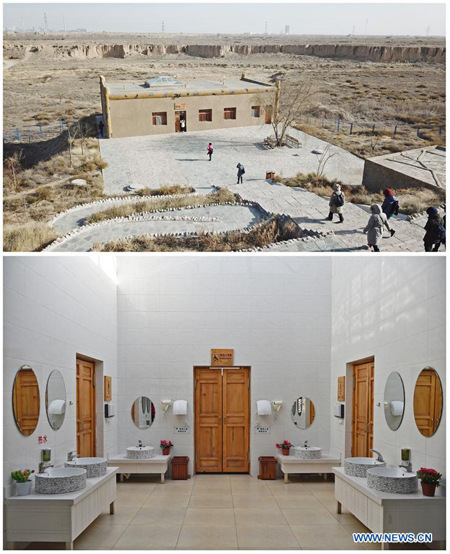
Combo photo shows the exterior scene (up) and the interior scene (bottom) of a public toilet at the Shuidonggou scenic area in Yinchuan City, capital of northwest China's Ningxia Hui Autonomous Region, Nov. 28, 2017. Nearly 300 million yuan (45.4 million U.S. dollars) have been spent in installing or renovating 481 toilets at tourists sites in Ningxia since 2015. (Xinhua/Li Ran)
The bathroom of Narenhua's guesthouse now has a flush toilet, and an electric water heater guarantees hot water all day long.
"The hygiene standards here are getting better these days, and more tourists are coming," said Narenhua, who lives on nearly 400 hectares of grassland near Bayannur in north China's Inner Mongolia Autonomous Region.
"The population is quite small on the grasslands, and there was a very limited number of toilets here," she said. "People usually answered nature's call in the open."
As the number of visitors has increased in recent years, complaints also grew, especially during peak season, as the guesthouse had no toilet or bathroom.
In 2015, Narenhua's family built a dry toilet about 200 meters from the house.
"The toilet environment soon got bad, especially in the summer, it smelt really bad," she said. "There were a lot of flies, and the odor was simply choking."
One year later, the local government decided to promote tourism on the grasslands by offering local herders subsidies for running guesthouses. In July 2016, Narenhua built a new guesthouse next door, with tap water, a water heater and flush toilet facilities.
"Within just half a year, the new guesthouse has welcomed more than 200 tourists," she said. "In November this year, I accommodated a film crew."
Since 2015, the regional government has advanced the national "toilet revolution" into rural areas and tourist sites in Inner Mongolia.
The Chinese government launched its "toilet revolution" across the country in 2015 with an aim to make the most notorious facilities cleaner and more regulated. It planned to add 33,000 public restrooms and renovate 24,000 between 2015 and 2017.
Some 52,485 toilets have been installed or upgraded from 2015 to the end of April this year, according to the China National Tourism Administration.


















































